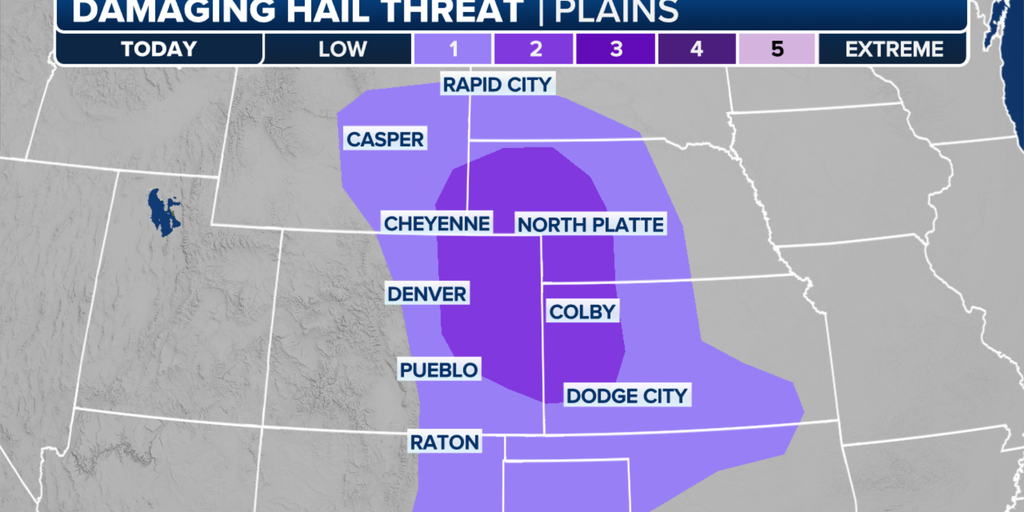Severe Weather Unleashed: Understanding the Threats Across the Great Plains
As skies darken and the winds swell, residents of the Great Plains brace for an onslaught of severe weather that could reshape their landscapes and lives. On a recent Sunday morning, the National Weather Service issued dire warnings for damaging winds and hail the size of golf balls, sending scores of people scrambling for safety while forecasters honed in on the impending chaos. In areas from Dodge City, Kansas, to Denver, Colorado, the atmospheric conditions converged to spell disaster—a foreboding reminder of nature’s fury.
The Current Landscape of Severe Weather
The situation remains critical, as experts assert that extreme weather events are on the rise. Dr. William Smith, a meteorologist at the Climatic Research Institute, emphasizes the connection between climate change and increasingly severe weather patterns. “We are seeing a significant uptick in the frequency and intensity of storms across the Plains, and the data suggests that this trend will only continue,” he states.
Winds and Hail: The Twin Threats
On that fateful Sunday, NOAA’s Storm Prediction Center assigned a “level 3 out of 5” threat for damaging winds, with gusts anticipated to reach speeds of up to 75 mph. The hail threat loomed just as large. Denver and Dodge City were categorized under a similar level 3 alert for monumental hail, with potential hailstones growing to the size of eggs, measuring up to two inches in diameter. According to predictions from FOX Weather, this dual hazard warranted urgent attention:
- Damaging Winds: Up to 75 mph, targeting areas including Dodge City and Denver.
- Severe Hail: Golfer-sized hailstones potentially wreaking havoc.
- Flooding Risks: Subsequent rainfall could lead to flash flood scenarios in low-lying areas.
The Science Behind the Storms
As meteorological models evolve, so too does our understanding of these dynamic systems. A hypothetical study conducted by the U.S. Weather Association indicates a 30% increase in storm intensity since 1980, correlating directly with rising global temperatures. “We can no longer view severe weather as fleeting anomalies—these are the new norms,” asserts Dr. Emily Thompson, a prominent climate scientist. “Understanding this helps governments and communities prepare more effectively.”
Preparedness and Response
In the face of threats from Mother Nature, preparedness becomes paramount. The Federal Alliance for Safe Homes (FLASH) has launched initiatives aimed at educating communities about tornado safety and general storm preparedness. Leslie Chapman-Henderson, the organization’s President and CEO, emphasizes the importance of personal responsibility: “The first step in protecting your home and family is to be informed. Awareness of risks is crucial to survival.”
Two essential preparedness steps include:
- **Emergency Kits:** Stock non-perishable food, water, and medical supplies.
- **Safe Spaces:** Identify a designated storm shelter or interior room where you can take cover.
The Ongoing Challenge of Climate Adaptation
The severe weather threats facing the Great Plains are not just immediate crises; they are emblematic of a larger climate challenge that demands a systemic response. Community leaders are rallying for enhanced infrastructure, such as improved drainage systems to mitigate flooding and better forecasting technologies. “Communities can benefit from investment in adaptive strategies that reduce vulnerability,” notes Dr. Mark Lee, a sociologist focused on climate resilience.
Future Considerations
As people continue to grapple with these mounting natural disasters, public perception is also shifting. Recent surveys indicate that a growing majority of residents believe their communities must adapt to changing climate conditions. This shift in mindset underscores an awakening—one that acknowledges the fragility of the environment. However, infrastructure changes alone are not sufficient without community engagement and education.
While the storms of the Great Plains may rage on, with each severe weather event comes an opportunity for resilience and learning. As schools, families, and local governments come together, they become a part of an ongoing narrative in which preparedness transforms from a reactive impulse into a proactive lifestyle. The fledgling sense of community responsibility may hold the key to navigating the churning waters of climate change—a collective act of defiance against the whims of the weather.









